Hiking Pants are another key part of your hiking kit. There are a myriad of options available and the quality that is available these days is exceptionally good.

This is definitely one area where I have noticed real improvements over a relatively short period of time. The pants available today are definitely far more comfortable than their older compatriots.
The biggest difference I have noticed is in the material make-up, I personally find the material used in hiking pants to be much more comfortable these days, and seemingly getting more and more so as every year goes by.
So, this is a buying guide of course so I want to add some notes on what to look for when trying to choose the best hiking pants for your needs.
If you just want to know the best hiking pants available on the market today, you can check out our best hiking pants options for men and our top hiking pants recommendations for women.
Moving back to buying advice, there are several things to think about but overall, let’s start with the good news.
For an average hiker doing average day hiking, I don’t think you need to break the bank for a decent pair of hiking pants. We’ll look at price in more detail further below but I though a short note on that would be good, it’s nice to get started on a positive note 🙂
Where do you Hike?
Before getting into the detail of what to look for when choosing your hiking pants, the first thing you should think about, is where you go hiking. This is probably the primary determining factor in choosing hiking pants.
For example, if you’re an average weekend day hiker in temperate climates, then a relatively standard pair of hiking pants, combined with rain pants, should see you good most if not all of the year round.

If however, you hike in predominantly warm conditions, say a desert climate like in parts of California and Nevada, then you may only want a light pair of hiking pants that can convert into shorts.
If you’re planning to visit a jungle for some hiking in the near future, then you may have other things to consider, e.g. bugs and so on.
Without going on too much, the main point I want to get across here, is that where you hike and the climate you hike in, will have a major influence on how you make the rest of the decisions in the additional sub heading areas below, so get that clear in your head first.
Types of Hiking Pants
There are more or less three types of hiking pants. Lets start with a brief introduction to each kind. I won’t go into too much more detail in this section, I’ll do that in the further sections below.
Good Old Fashioned Pants
The first type are good fashioned pants. No different, except in function and design of course, to any other type of pants.
Convertible Hiking Pants
The second are convertible hiking pants. These are hiking pants on which the bottom legs can be removed to enable you to create a pair of shorts. The bottom part of the legs are usually removed using zips which run sideways around the leg.
Roll-up Hiking Pants
These are hiking pants that roll up into shorts or Capri pants. Can be handy for extra ventilation.
Material
This is the area I have noticed really significant changes over the last decade. Broadly speaking, synthetic materials such as nylon and polyester are the main materials you will find in hiking pants.
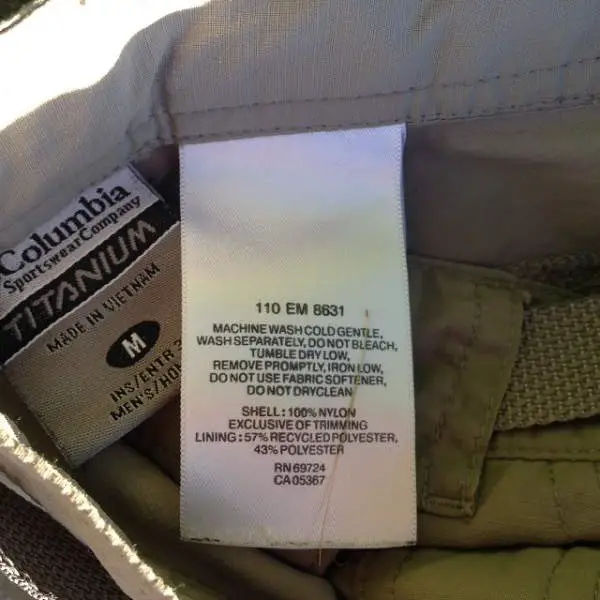
However, a lot of modern Hiking pants available on the market today come in a very comfortable and stretchable fabric made from a combination of nylon with some spandex or elastane.
I have really noticed how much more comfortable hiking pants that employ this type of make-up are than what was available even a few years back. I put it that all down to the material combination changes.
What I’ve also noticed is that this kind of material make-up can really lend itself to some of the other key items, that you want to have your hiking pants to have, namely breathability and water resistance.
This of course varies depending on the type of pants and their specific function. That is, a light summer hiking pant will of course be a lighter construction and fabric weave than a heavier winter pant.
A heavier pair of pants will also have a thicker and tougher fabric weave and likely some extra water resistance capabilities on the face of the fabric, more about that below.
One phrase you will come across in terms of material for good hiking pants, and other hiking gear, in terms of material construction, is ripstop. Ripstop fabrics are woven fabrics that are made using a special technique which reinforces them.
This of course makes them tougher and more durable, a perfect fit for the kind of things you will be putting you hiking pants through on the trail!
Is there a best material for hiking pants? I can’t say there is one specific material, a mix of materials like nylon, polyester, elastane, is the way to go.
You want a strong stretch fabric that will enable you to move comfortable as you hike. You also of course want to avoid cotton as it isn’t best suited as a material for hiking pants, neither is linen.
The material in your hiking pants will play a big part in the next thing we will look at which is …
Weight
Weight is a factor that will have more, no pun intended, weight in the buying choice for some than others.
What I mean by that is that a day hiker may be much happier to carry a bit of extra weight in their hiking pants, than a thru hiker or a backpacker heading out for a week or longer would.
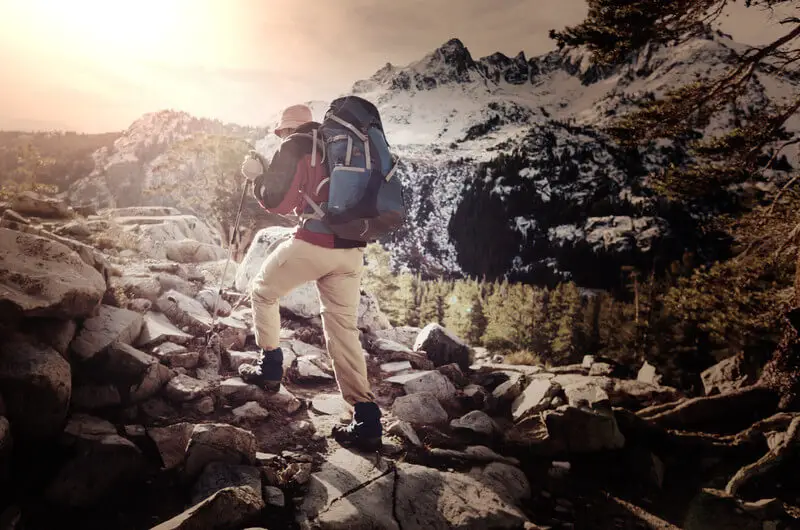
As a general rule, the more suited to hot weather your hiking pants are, like a summer hiking pant option, the lighter they will be. As mentioned, the material used also plays a big part in this.
It stands to reason that generally the material in summer will be less thick than a pair of hiking pants you would need to wear in winter, when it’s usually colder.
Now, I hesitate a little in saying that as even in areas with hot weather the temperature can plummet when night time rolls around. A desert is a good example of this.
Really hot during the day, but much cooler, sometimes very cold, at night. Similarly, in certain places in Winter on a sunny day, it can be very chilly in the shade but hot when in direct line of the sun.
For an average day hiker, weight shouldn’t be a major concern and you can pick what feels comfortable to you. For a backpacker, it definitely becomes more of a factor that you need to take into consideration, as you will probably want as light and efficient of an option as possible.
Sizing
Everyone will of course have their own preference for sizing. First and foremost you want your hiking pants to feel comfortable (of course). I think good mobility in them is very important so a certain amount of bagginess is a good thing. However, you don’t want to go overkill on this either.
You will definitely want good mobility in the crotch and knee areas. When you hike over varying terrain you will be moving those areas the most and into the widest variety of positions, so you want a bit of freedom in movement for sure.
Some pants will specifically have things like articulated knees and gusseted crotches so they can be good to look out for too, as they will offer more mobility with added resistance to abrasion.
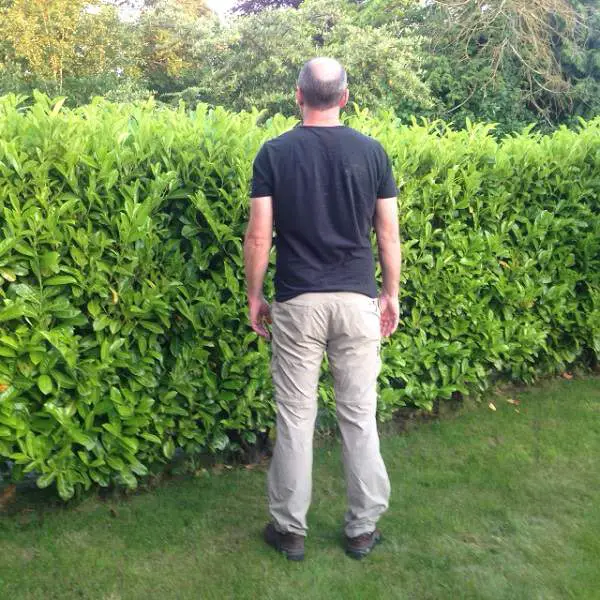
As a general rule, Summer hiking pants are usually that bit baggier than Winter ones. This makes some sense as you want more ventilation in hotter temperatures.
I always like some element of bagginess in my hiking pants. However, I have found that some more modern hiking pants, using the spandex combination mentioned above, can be quite snug in terms of fit but still be very flexible in terms of movement.
Overall, and this may be somewhat stating the obvious but, in terms of sizing aim for what feels comfortable to wear and pay a pit of extra attention to the knee and crotch areas.
A little bagginess can be good for hotter times of year, as air can circulate a bit better, but don’t go too crazy as too much and it will be a pain e.g. flapping in heavy winds.
Breathability
As with any hiking, you want your pants to be breathable. This is a lot to do with the material make-up from the previous section. Your hiking pants need some breathability to ensure you can let your legs breathe i.e. sweat can wick away from your skin.
While that is important, it is only part of the process and I think additional features like ventilation zips for quick ventilation are a great thing to have but we’ll look at that in more detail below.
Good breathability also lends itself to helping your hiking pants to dry out quicker if they get wet. I can’t overstate how important that is. Your hiking pants are going to get wet so the quicker they can dry off the better.
Water Resistance / Waterproof
I’m a little cautious of hiking pants that are categorized as waterproof. In terms of hiking, waterproof capability should generally be handled utilizing your rain pants in my opinion.
However, some element of water resistance on a thicker pair of hiking pants, for autumn / winter, can be a good thing to have. It just means that for a lighter shower of rain, you don’t need to get your rain gear out and on.
This will be provided by a DWR (Durable water repellent) coating of some kind. This sits on top of the material and beads the water letting it roll off.
The DWR coating won’t last forever though, so you do need to reproof the coating on your hiking pants, using Nikwax or a similar reproofing product, if you want to keep the water resistance working well.
For summer hiking, I don’t concern myself too much with water resistance in hiking pants. If the pants have good breathability and they get a bit wet they normally dry off pretty quickly in the warmer temperatures of summer.
If the rain is too heavy, I just pop the rain pants on over my hiking pants till it passes.
As I mentioned, for serious rain, I always prefer to rely on waterproof rain pants as an outer layer over my hiking pants but this may not always be as comfortable in certain scenarios, say in very muggy conditions.
You’ll need to see what set-up works best for your needs based on where you do your hiking.
Windproof
This should be more or less covered by the material make up, and the waterproof capability can help a bit with this too.
However, having god hiking pants that can hold off a blast of heavy wind is a good thing to have.
Again, this will depend on where you are hiking and when. If you head into the Scottish highlands on a blowy late autumn day, you will most definitely need your hiking pants to shield you from the wind.
If on the other hand, you are out on a hot summers day in Zion national park in Utah, it may not be high on your requirements list.
UPF
Some summer hiking pants will have an extra UPF (Ultraviolet Protection Factor) capability in the material make-up of them. Before getting into this, I think it’s worth covering the difference between UPF (Ultraviolet Protection Factor) and SPF (Sun Protection Factor) so as not to get confused.

An SPF rating is a rating that indicates how fast skin will burn. So the SPF ratio of 20 means that 1/2oth of the burning radiation will reach the skin.
So, if you use sunscreen with a factor of 20, it will take 20 minutes for an equivalent of 1 minute of burning radiation to get through to your skin if you were not using sunscreen. It’s only a guide though so if you’re hiking in the heat using sunscreen, it’s always better to top up on it regularly.
UPF on the other hand is a clothing rating that works by indicating the number of units of ultraviolet light an item of clothing let’s in through the fabric. It’s a ratio that works as follows.
If a clothing item has a UPF of 40, it means that if 40 units of UV fall on the fabric, only 1 unit will pass through to the skin. In summary, when we’re talking about hiking gear, we are only concerned with UPF, the rating for clothes.
It’s worth noting here that standard clothing alone will provide some element of protection from the sun. If you’re wearing your normal clothes out in sunny conditions, it is rare that you will actually get sunburn through them.

However, the sun is something you need to be very conscious of when out on the trail as on a good day, you’re totally exposed. Often times you are often that bit closer to the sun as well, as you’re generally higher up in terms of altitude.
The temperature can also be a little cooler in that scenario which can be a little deceiving as to the amount of UV you’re actually getting exposed to is much higher than it may feel to your body.
Similarly, if you live closer to the equator, the sun can be a lot stronger and you may burn a lot easier. Some folks also have skin that is more prone to burning than others, so this may be more of a red flag for some than others e.g. people with fair skin.
People are also of course different. Some people can handle a lot more direct sun than others. If you have pale white skin, then you are probably more likely to need more protection than others.
Overall, having a UPF rating is something to consider as part of your hiking pants buying decision should you hike in sunnier and hotter climes.
Personally, I think there is no harm in having some UPF capability in a light summer hiking pant if you hike in a lot of hot sunshine or in certain locations or environments e.g. deserts.
UPF is a broad topic and one that is worth learning more about. This article on REI goes into UPF and sun protection in clothing in further good detail. Worth a look as an additional resource, if you want to go into it in more detail.
Color
Color is important. Hiking pants come in a range of colors but again thinking in terms of heat, dark colors absorb heat and light colors reflect heat. So, this is why nearly all light summer hiking pants will be grey, beige, cream, etc. A much better color to have in hot temperatures.
Similarly, if you’re hiking in winter, a darker pair of hiking pants can help to absorb heat from the sun and help keep you warmer. It may sound a bit like overkill but it does have an impact.
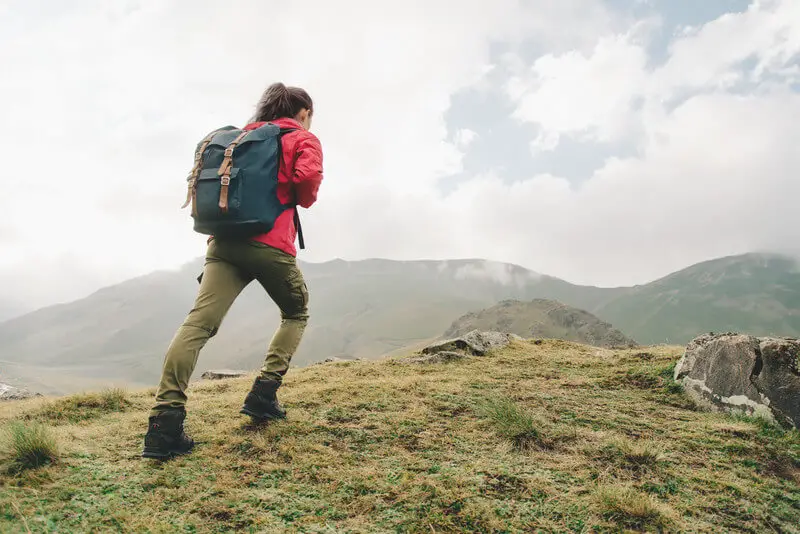
Again, for someone who is out for longer times, say trekkers and backpackers, this is something to really give more consideration too as the wardrobe you can carry on your back will be limited 🙂
Bug Resistance
Again, something to consider for many, bug resistance in your hiking pants will help keep bugs at bay. This can be a real problem in many places and so anything that may help with this may be worth considering.
If you’re planning on heading away on a hiking adventure, say to the Amazon or somewhere, that’s when capabilities like this may be much more important to help protect you from getting bitten by various bugs and whatnot.
In saying that though, mosquitoes, ticks, ants, flies, chiggers and midges are never too far away in most parts of the world.
I think most places at a certain time of year in their cycle will have some kind of explosion in bugs / mosquitoes, etc. Therefore, insect shield technology can be worth considering for sure.
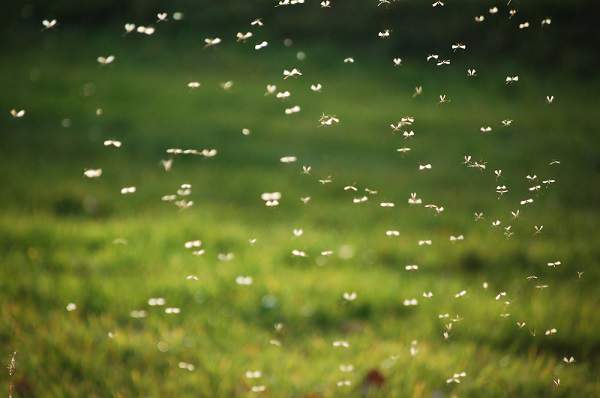
Of course, this an only ever be an aid to protect yourself from bugs. You need proper bug repellent as your main line of defense. Bug resistance in your hiking pants is only a bonus, and should never be relied on as your main shield of protection.
Pockets
Good pockets are a must on hiking pants in my opinion. I like deep ones, at least the standard two hand pockets should be deep. Hand pockets can sometimes be zipped, and usually zipped pockets in hiking pants will have a bit more water resistance.
You can see as an example below, that my Columbia summer hiking pants have a lot of pockets available.

That’s just one side view shot in the photo above and it has four available pockets: one standard hand pocket, a zipped back pocket, a hidden secure pocket and the side pocket.
The other side has 3, less the hidden pocket, and the back pocket uses a Velcro closure. Point being, there is plenty of available pocket space. Really handy to have.
As in the Columbia hiking pants above, some hiking pants will come with a small zipped inner, almost hidden, secure pocket, usually just on the entry to the right hand pocket of the pants.
This can be used to store something you really don’t want to lose e.g. a car key. The space is usually quite small in the pocket though but it’s a neat thing to have.
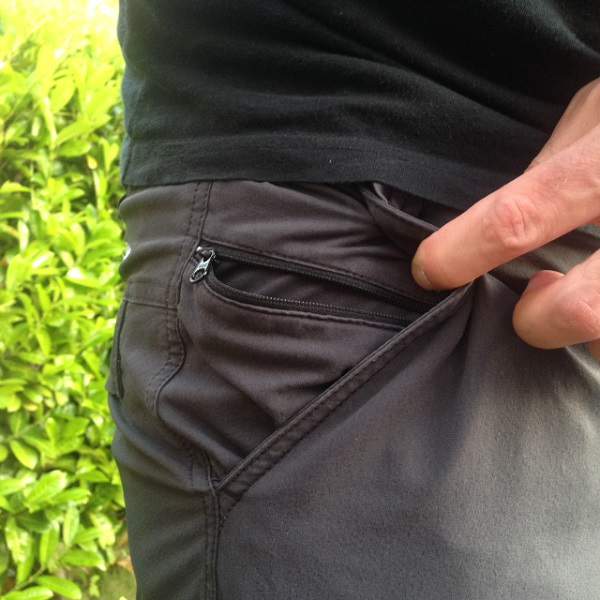
Hip pockets can also feature on hiking pants, one or two can be handy to have, but not always practical. They usually can be closed with buttons, Velcro or zips.
Rear back pockets are also common on hiking pants, not a major concern of mine as I don’t use the rear pockets a lot, but again no harm to have them.
Care
This could have slotted into the material section above, but it’s worth calling it out in it’s out section, to highlight it.
Nearly all good hiking pants should be relatively easy to care for. So to wash and drip dry should be pretty standard.
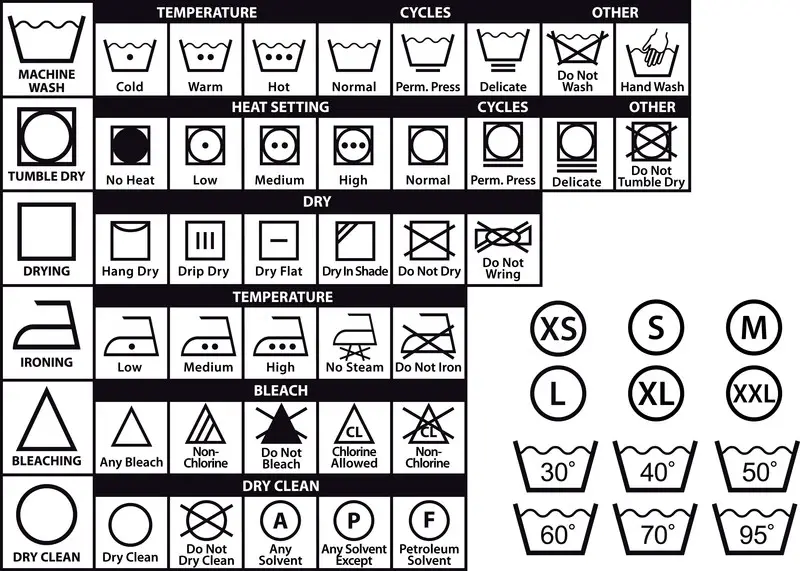
However, it is worth checking on this before you buy. If you get hiking pants that have a very specific material construction, say to enhance their water resistance capability, then you may need to care for them in a more specialized way, using special detergents, or that type of thing.
I don’t like this idea, I want to be able to wash my hiking pants simply and easily, with other dirty sports gear. I have my rain pants that need special love and TLC, in terms of reproofing every so often etc., and that is enough for me.
Also, hiking pants that can be washed by hand are useful to have. If you are on a long trek and can’t get to a proper washing machine facility, even giving them a bit of a rinse in a bathtub or bucket with detergent can be helpful, to get them a bit less smelly after days of use 🙂
The material make-up of most hiking pants, lend themselves to this, but it’s something to keep in mind if considering care and attention.
Features
For summer hiking pants, I look for removable bottoms. This means you can easily turn your hiking pants into shorts, also known as, convertible hiking pants. I have a pair of Columbia light hiking pants that do this and it works very well.
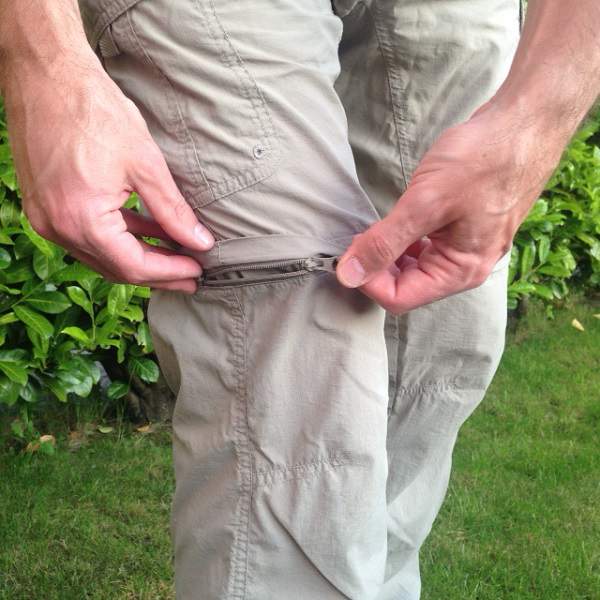
There are two zips around the pants at just above the knee level and the lower part of the pants easily zip off. Really handy for when you’re not sure if the sun will make an appearance on the day or not.
While shorts in the sun is a good idea, be careful as if it’s too hot you might be wiser to leave them on to protect your legs from the sun.
Another handy thing about the removable bottoms is that they can be removed and washed really easily. When you’re hiking, the bottom of the pants will get the worst hit in terms of dirt.
If you can’t wash them for a few days while you hike, you can simply detach the bottoms and rinse them in a river or a sink, whatever is handy. I did this when I hiked the Camino and it worked a treat and kept me looking somewhat respectable after numerous days hiking lol 🙂
A similar effect, making your pants into shorts, can also be achieved using roll-up hiking pants. The bottoms on these can be rolled up to form shorts or Capri pants.
In truth, you can roll up most standard hiking pants just fine but these ones will have a tie feature available so you can secure them when rolled up.
Not something I’ve used personally but might be good to have if you find the process of removing zipped bottoms a hassle as you have to take your boots off.
In more durable hiking pants, a key feature I really like to have are ventilation zips. These work in the same format as pit zips in a rain jacket.
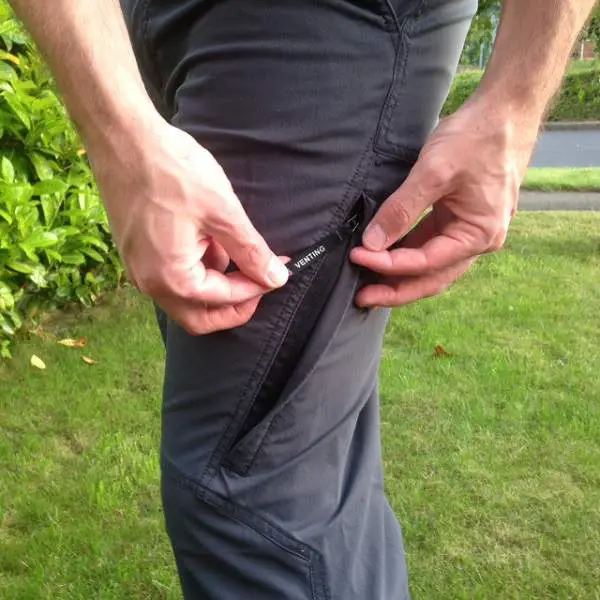
They run along the side of the hip and usually have a mesh material under them which allows good air flow when you open them.
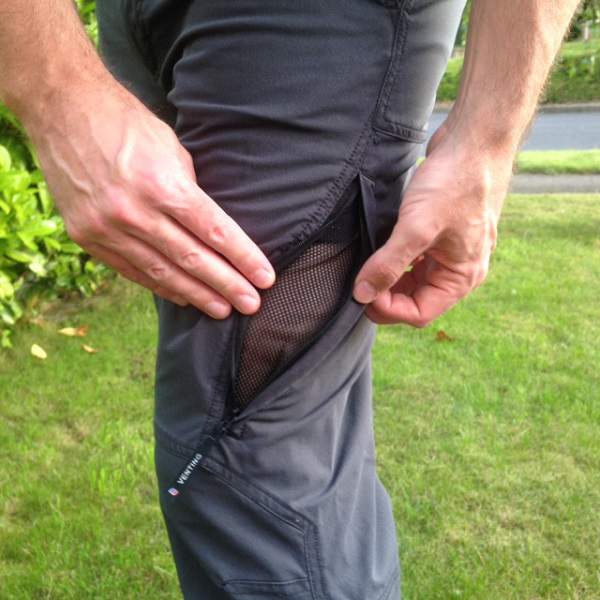
They’re a very effective way to quickly regulate the temperature in your hiking pants and I really like them. Breathable material is one thing but the quick venting option is the business in my opinion.
You can open them as you ascend a steep part of a mountain when you’re sweating that bit more with the extra exertion. Then when you get to a plateau or start heading downward, you can just zip them back up if it starts to get too cool.
In terms of zips, boot zips are also a popular feature to look out for. These are zips that run from the bottom of your hiking pants up to, approximately, the top of your ankle. When open, they can help with sliding boots on and off and they can also allow some element of ventilation.
Hiking pants will also often feature some way to secure at the waist. This will either be with belt loops to which you use your belt of choice but many hiking pants will come with an integrated Belt or drawstring of some kind.

Some kind of belt, integrated or otherwise, is useful as it allows an element of weight moderation, when you fill up the many pockets available to you with stuff, you need something to help keep the pants comfortably up and secure.
You can also look for a lined waistband, for example, a brushed Tricot-Lined waistband. This means that the waistband has a lining that makes it a little more comfortable to wear, as the waistband will be touching your skin.
Finally, if you will be using a harness, then you may want to look for hiking pants that specifically mention harness compatibility. Not a major requirement for most average hikers, but something worth noting.
Price
In terms of getting a very functional and comfortable pair of hiking pants for the trail, I really don’t feel you need to break the bank. You can of course spend a lot of money on hiking pants, as with all hiking gear there is a lower and upper range running from about €50.00 to €100.00.
However, I think spending in and around $80.00 (maybe a bit less if you take advantage of a sale or some coupons online) will get you a really good and functional brand name pair of hiking pants.
The more functionality you have in your pants, generally the more expensive they will be. What I mean by that is, all else being equal, a light pair of hiking pants should be a bit cheaper than a tougher and more durable Winter pair.
Keep in mind that brand name can have a big impact on price too. I do generally like particular brands over others, as most people do, but sometimes you won’t get much more in functionality and capability for the extra dollars you will pay for a name.
It is also true you can possibly find a bargain in a non brand pair of hiking pants on Amazon or in a local budget store. If you spend 10 bucks on a pair of pants though, set your expectations accordingly, you might get lucky and have found a really great deal, but you might not 🙂
My Recommendation
I recommend having at least two sets of hiking pants, a summer pair that are lighter and have some specific functions, which I list below, as well as a winter pair which are of course that bit heavier to keep you warmer in colder climates.
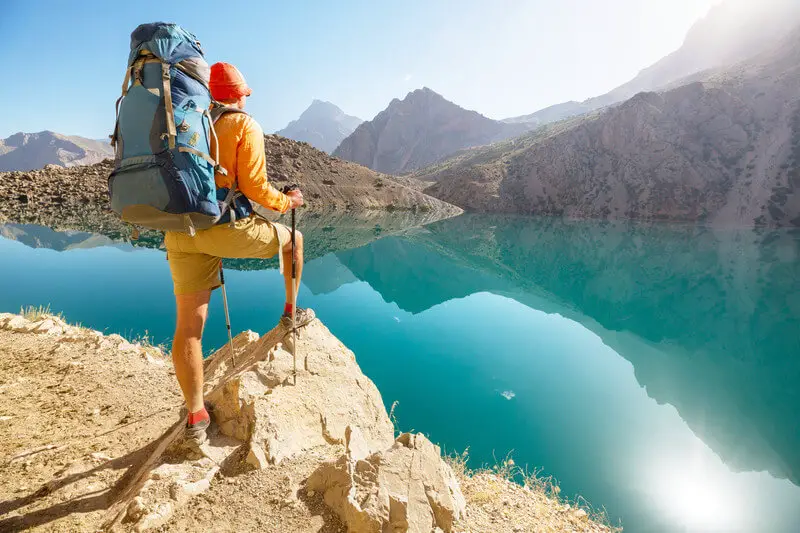
The summer hiking pants should be convertible into shorts. I prefer the capability to remove the bottoms using zips as opposed to roll-ups but whatever you prefer should be fine and will have the same effect.
For the autumn / winter hiking pants, I recommend a tougher material construction for the hiking pants, they need to be considerably warmer but still breathable.
I like a mix of synthetic fiber like nylon / polyester with some spandex or elastane into the mix to allow a bit more stretch in the fabric. I recommend you look for ventilation zips in your winter pants as I think they are really effective in helping regulate temperature.
Breathability is also very important for both your summer and winter hiking pants. As mentioned above, generally speaking, the more breathable, the quicker the pants can dry and that is a definite requirement for hiking pants.
Look for at least two hand pockets in each pair and a couple of back pockets, can also be useful. A zipped pocket or two can also be good to secure something away.
If you’d class yourself as a casual hiker, I think it is feasible to get away with one year round pair of hiking pants, for that I’d choose a middle of the road hiking pant.
Ones that are not too light for winter but not too heavy for summer, ideally with removable bottoms so you can turn the hiking pants into shorts.
That combined with good waterproof rain pants should keep you covered in most conditions.
Conclusion
Hiking pants are a key part of your hiking gear, there is no doubt about that. The good news is that the quality available these days I think is really top notch at a price that is affordable.
You can check out our best hiking pants options for men here and our top hiking pant recommendations for women. We walk through a lot of excellent options to choose from in those articles.
As mentioned above, hiking pants are one area I’ve really noticed a big change in quality in over the last decade and they seem to be getting better and better.
As with all hiking gear, it will be interesting to see how technology advancements help further enhance the quality and capability of hiking pants over the coming years. It should only be good I think.
I hope you found this article on how to choose the best hiking pants useful. Please share it around your networks if you did 🙂
Very informative article, I would be sure to avoid cotton material when going outdoor. Cotton retains sweat making it very uncomfortable.
Definitely, wearing cotton on the trail isn’t a good idea.
What do you think about ‘tactical’ pants esp. the poly/cotton ripstop versions? Many are designed like as cargo pants, as the cargo pockets are meant to carry ammunition.
Many were fashioned after the TCU/BDU of the military. The looser fit versions are very comfortable similar to BDUs.
There are cotton canvas versions for cooler/colder weather as well.
Thanks!
I’ve never owned a pair so can’t say a lot about them. I had a look online though and they seem good.
Plenty of storage, functional and affordable. It would make sense that practicality would be top of the list for pants based on military needs.
However, in terms of hiking, I’m always cautious when I see cotton in the material make-up. Just in terms of them getting wet, how quick will they dry off, how breathable are they, and so on.